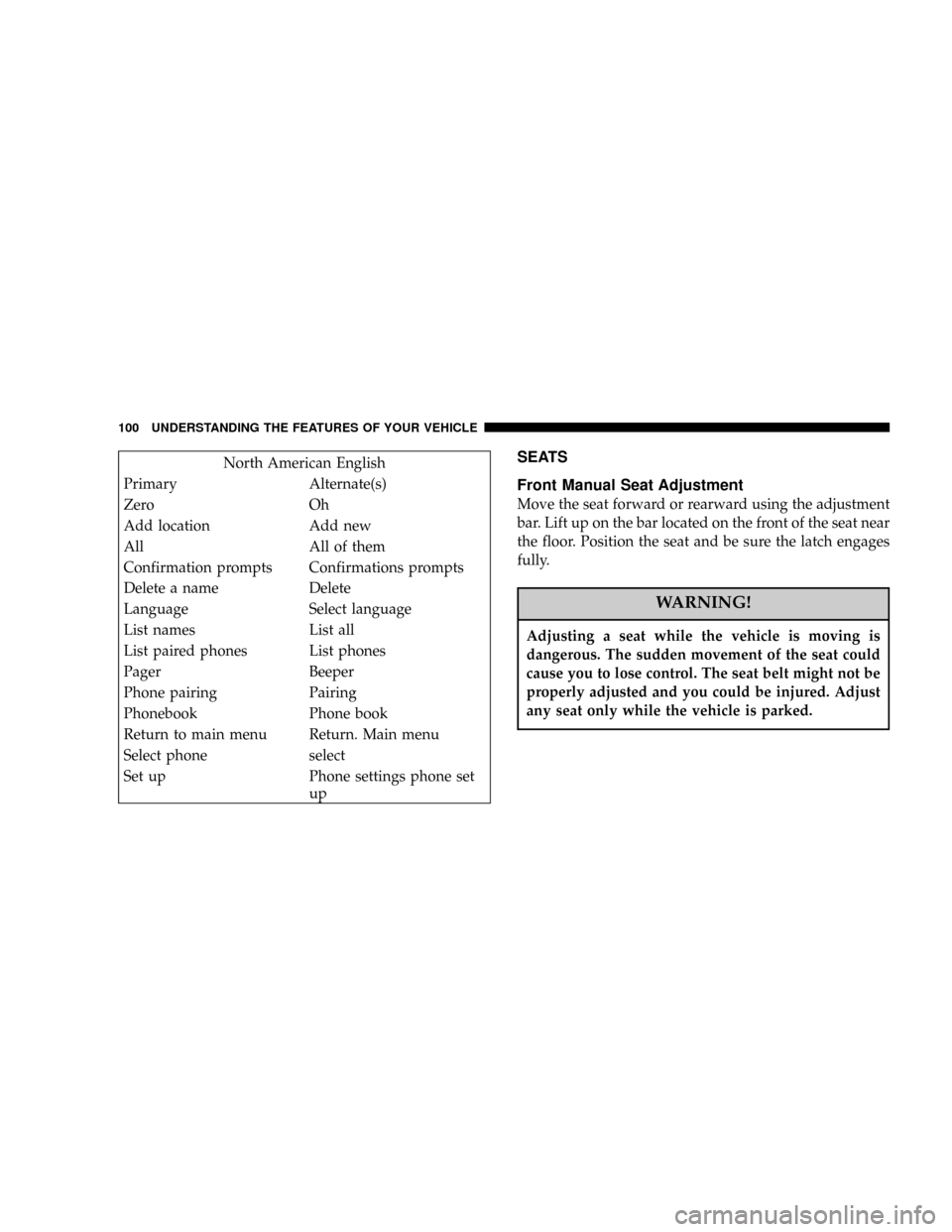seat adjustment JEEP GRAND CHEROKEE 2007 WK / 3.G SRT Owners Manual
[x] Cancel search | Manufacturer: JEEP, Model Year: 2007, Model line: GRAND CHEROKEE, Model: JEEP GRAND CHEROKEE 2007 WK / 3.GPages: 395, PDF Size: 6.1 MB
Page 69 of 395

UNDERSTANDING THE FEATURES OF YOUR VEHICLE
CONTENTS
mMirrors...............................74
NAutomatic Dimming Mirror...............74
NOutside Mirrors.......................75
NExterior Mirrors Folding Feature...........75
NDriver's Outside Automatic Dimming Mirror Ð
If Equipped..........................76
NPower Remote Control Outside Mirrors......76
NHeated Remote Control Mirrors Ð
If Equipped..........................77
NLighted Vanity Mirrors Ð If Equipped.......77mHands±Free Communication (UConnectŸ) Ð
If Equipped............................78
NOperations...........................79
NPhone Call Features....................86
NUConnectŸ System Features..............88
NAdvanced Phone Connectivity.............93
NThings You Should Know About Your
UConnectŸ System.....................94
mSeats................................100
NFront Manual Seat Adjustment............100
3
Page 70 of 395

NFront Seat Adjustment Ð Recline..........101
NManual Lumbar Support Adjustment.......102
N8 - Way Driver's Power Seat..............102
N4 - Way Passenger's Power Seat Ð
If Equipped.........................103
NHead Restraints......................103
NHeated SeatsÐIf Equipped..............103
N60/40 Split Rear Seat...................105
mDriver Memory Seat Ð If Equipped.........107
NSetting Memory Positions And Linking Remote
Keyless Entry Transmitter To Memory.......108
NMemory Position Recall.................109
NTo Disable A Transmitter Linked To Memory . . 110
NEasy Entry/Exit Seat...................111mTo Open And Close The Hood.............112
mLights...............................114
NMulti-Function Control Lever.............114
NBattery Saver FeatureÐExterior/Interior
Lights.............................114
NHeadlights And Parking Lights...........115
NAutomatic Headlight System Ð If Equipped . . 115
NSmartbeams Ð If Equipped..............116
NInstrument Panel And Interior Lights.......117
NDaytime Running Lights Ð If Equipped.....117
NLights-On Reminder...................118
NFog Lights Ð If Equipped...............118
NTurn Signals.........................118
70 UNDERSTANDING THE FEATURES OF YOUR VEHICLE
Page 100 of 395

North American English
Primary Alternate(s)
Zero Oh
Add location Add new
All All of them
Confirmation prompts Confirmations prompts
Delete a name Delete
Language Select language
List names List all
List paired phones List phones
Pager Beeper
Phone pairing Pairing
Phonebook Phone book
Return to main menu Return. Main menu
Select phone select
Set up Phone settings phone set
upSEATS
Front Manual Seat Adjustment
Move the seat forward or rearward using the adjustment
bar. Lift up on the bar located on the front of the seat near
the floor. Position the seat and be sure the latch engages
fully.
WARNING!
Adjusting a seat while the vehicle is moving is
dangerous. The sudden movement of the seat could
cause you to lose control. The seat belt might not be
properly adjusted and you could be injured. Adjust
any seat only while the vehicle is parked.
100 UNDERSTANDING THE FEATURES OF YOUR VEHICLE
Page 101 of 395

Front Seat Adjustment Ð Recline
To adjust the seatback, lift the lever located on the
outboard side of the seat, lean back, and release the lever
at the desired position. To return the seatback, lift the
lever, lean forward, and release the lever.
WARNING!
Do not ride with the seatback reclined so that the
seat belt is no longer resting against your chest. In a
collision you could slide under the seat belt and be
seriously or even fatally injured. Use the recliner
only when the vehicle is parked.
WARNING!
²It is extremely dangerous to ride in a cargo area,
inside or outside of a vehicle. In a collision,
people riding in these areas are more likely to be
seriously injured or killed.
²Do not allow people to ride in any area of your
vehicle that is not equipped with seats and seat
belts.
²Be sure everyone in your vehicle is in a seat and
using a seat belt properly.
UNDERSTANDING THE FEATURES OF YOUR VEHICLE 101
3
Page 102 of 395

Manual Lumbar Support Adjustment
The manual lumbar support adjustment lever is located
on the right side of the driver's seat and on the left side
of the passenger's seat. Moving the lumbar control lever
fore and aft increases or decreases the lumbar support.
8 - Way Driver's Power Seat
The driver's power seat switches are located on the
outboard side of the driver's seat lower side trim. The
bottom switch controls up/down, forward/rearward,
and tilt adjustment. The top switch controls the seatback
recline adjustment.
Manual Lumbar Control
Power Seat Switches
102 UNDERSTANDING THE FEATURES OF YOUR VEHICLE
Page 103 of 395

4 - Way Passenger's Power Seat Ð If Equipped
The front passenger's power seat switches are located on
the outboard side of the passenger seat lower side trim.
The bottom switch controls forward/rearward adjust-
ment. The top switch controls the seatback recline adjust-
ment.
NOTE:The 4 - way seat does not have an up/down
adjustment.
Head Restraints
Head restraints can reduce the risk of whiplash injury in
the event of impact from the rear. Adjustable head
restraints should be adjusted so that the upper edge is as
high as practical. The head restraints have a locking
button which must be pushed in to lower the head
restraint to all positions. The restraints may be raised
without pushing in the button.
Heated SeatsÐIf Equipped
Heated seats provide comfort and warmth on cold days
and can help soothe sore muscles and backs. The heaters
provide the same heat level for both cushion and back.
The front driver and passenger seats are heated. The
controls for each heater are located near the bottom
Adjustable Head Restraints
UNDERSTANDING THE FEATURES OF YOUR VEHICLE 103
3
Page 223 of 395

LO AUTO position should be used for front seat occu-
pants only. The HI AUTO position should be used when
more air flow is desired, or when rear seat occupants are
present. Dial in the comfort setting you would like the
system to maintain by rotating the driver's or passenger's
control knob. Once the comfort level is selected the
system will maintain that level automatically using the
heating system. Should the desired comfort level require
air conditioning, the system will automatically make the
adjustment.
You will experience the greatest efficiency by simply
allowing the system to function automatically. Selecting
the OFF position on the fan control stops the system
completely.
NOTE:The temperature setting can be adjusted at any
time without affecting automatic control operation. How-
ever, if the driver and/or passenger temperature knobs
are set to the full hot or full cold positions, the airtemperature out of the ducts will be full hot or full cold
respectively. With the temperature setting in these posi-
tions, the system does not attempt automatic comfort
control.
The air conditioning in this system is automatic.
Pressing this button while in AUTO mode will
cause the LED to flash three times and remain off.
This indicates that the system is in AUTO and requesting
the air conditioning is not necessary.
The system will automatically control recircu-
lation. However, pressing this button will tem-
porarily put the system in recirculation mode.
This can be used when outside conditions such
as smoke, odors, dust, or high humidity are present. This
will cause the LED to illuminate.
NOTE:
²The surface of the climate control panel, and the top
center of the instrument panel should be kept free of
UNDERSTANDING YOUR INSTRUMENT PANEL 223
4
Page 390 of 395

Seat Belts.............................. 35
Adjustable Upper Shoulder Anchorage........ 40
And Pregnant Women................... 42
Child Restraint.......................54,62
Extender............................. 42
Front Seat............................ 35
Inspection............................ 66
Maintenance........................66,333
Pretensioners.......................... 41
Reminder............................ 177
Shoulder Belt Anchorage.................. 40
Seats................................. 100
Adjustment.......................... 100
Cleaning............................ 331
Easy Entry........................... 111
Head Restraints....................... 103
Heated............................. 103
Lumbar Support....................... 102
Memory............................. 107Power...........................102,103
Rear Folding......................... 105
Reclining............................ 101
Security Alarm (Theft Alarm).............18,174
Selection of Coolant (Antifreeze)............. 319
Selection of Oil......................... 307
Sentry Key (Immobilizer)................... 15
Sentry Key Programming................... 17
Sentry Key Replacement................... 17
Service Assistance....................... 370
Service Contract......................... 372
Service Engine Soon Light (Malfunction Indicator) . 172
Service Manuals........................ 374
Setting the Clock.....................197,210
Shifting............................... 238
Automatic Transmission................. 238
Shoulder Belts........................... 35
Signals, Turn................... 118,172,342,344
SmartBeams........................... 116
390 INDEX
Page 395 of 395

INTRODUCTION INTRODUCTION Roll Over WarningHOW TO USE THIS MANUAL WARNINGS AND CAUTIONS VEHICLE IDENTIFICATION NUMBER VEHICLE MODIFICATIONS / ALTERATIONS THINGS TO KNOW BEFORE STARTING YOUR VEHICLE A WORD
ABOUT YOUR KEYS Ignition Key RemovalKey-In-Ignition ReminderSENTRY KEY IMMOBILIZER SYSTEM Important Note About ServiceReplacement KeysCustomer Key ProgrammingGeneral InformationSECURITY ALARM SYSTEM - IF EQUIPPED To Set the Alarm
To Disarm the SystemILLUMINATED ENTRY REMOTE KEYLESS ENTRY To Unlock the DoorsTo Lock the DoorsTo Release the Liftgate Flipper GlassUsing The Panic AlarmGeneral InformationTransmitter Battery ServiceREMOTE STARTING SYSTEM - IF EQUIPPED
DOOR LOCKS Manual Door LocksPower Door Locks - If EquippedChild Protection Door LockWINDOWS Power WindowsWind BuffetingLIFTGATE Liftgate FlipperGlassOCCUPANT RESTRAINTS Lap/Shoulder BeltsLap/Shoulder Belt Operating InstructionsAdjustable Upper
Shoulder Belt AnchorageAutomatic Locking Mode - If EquippedEnergy Management FeatureSeat Belt PretensionersSeat Belts and Pregnant WomenSeat Belt ExtenderDriver And Front Passenger Supplemental Restraint Systems (SRS) Child RestraintENGINE BREAK-IN
RECOMMENDATIONS SAFETY TIPS Exhaust GasSafety Checks You Should Make Inside The VehicleSafety Checks You Should Make Outside The VehicleUNDERSTANDING THE FEATURES OF YOUR VEHICLE MIRRORS Automatic Dimming MirrorOutside Mirrors
Exterior Mirrors Folding FeatureDrivers Outside Automatic Dimming Mirror - If EquippedPower Remote Control Outside MirrorsHeated Remote ControlMirrors - If EquippedLighted Vanity Mirrors - If EquippedHANDS-FREE COMMUNICATION (UConnect) - IF EQUIPPED
OperationsPhone Call FeaturesUConnect System FeaturesAdvanced Phone ConnectivityThings You Should Know About Your UConnect SystemSEATS Front Manual Seat AdjustmentFront Seat Adjustment - ReclineManual Lumbar Support Adjustment8 - Way Drivers Power
Seat4 - Way Passengers Power Seat - If EquippedHead RestraintsHeated Seats-If Equipped60/40 Split Rear SeatDRIVER MEMORY SEAT - IF EQUIPPED SettingMemory Positions and Linking Remote Keyless Entry Transmitter to MemoryMemory Position RecallTo Disable
A Transmitter Linked to MemoryEasy Entry/Exit SeatTO OPEN AND CLOSE THE HOOD LIGHTS Multi-Function Control LeverBattery Saver Feature-Exterior/Interior LightsHeadlights and Parking LightsAutomatic Headlight System - If EquippedSmartBeams - If Equipped
Instrument Panel and Interior LightsDaytime Running Lights - If EquippedLights-On ReminderFog Lights - If EquippedTurn SignalsHigh Beam SwitchPassing LightHeadlight Time DelayInterior LightsFront Map/Reading LightsWINDSHIELD WIPERS AND WASHERS Mist
Speed Sensitive Intermittent Wiper SystemRain Sensing Wipers-If EquippedTILT STEERING COLUMN ADJUSTABLE PEDALS - IF EQUIPPED ELECTRONIC SPEED CONTROL To ActivateTo Set at a Desired SpeedTo DeactivateTo Resume SpeedTo Vary the Speed
SettingTo Accelerate for PassingDriving Up or Down HillsELECTRONIC BRAKE CONTROL SYSTEM ABS (Anti-Lock Brake System)TCS (Traction Control System)BAS (Brake Assist System)ERM (Electronic Roll Mitigation)ESP (Electronic Stability Program)ESP/BAS
Warning Lamp and ESP/TCS Indicator LightREAR PARK ASSIST SYSTEM- IF EQUIPPED Rear Park Assist SensorsRear Park Assist Warning DisplayEnable/Disable the Rear Park Assist SystemService the Rear Park Assist SystemCleaning the Rear Park Assist System
REAR CAMERA - IF EQUIPPED Turning the Rear Camera OnTurning the Rear Camera OffOVERHEAD CONSOLE Courtesy/Reading LightsSunglasses StorageGARAGE DOOR OPENER Programming HomeLinkCanadian Programming/Gate ProgrammingUsing HomeLink
Erasing HomeLink ButtonsReprogramming a Single HomeLink ButtonSecurityPOWER SUNROOF - IF EQUIPPED Opening Sunroof - ExpressClosing Sunroof - ExpressPinch Protect FeaturePinch Protect OverrideVenting Sunroof - ExpressSunshade OperationWind
BuffetingSunroof MaintenanceIgnition Off OperationSunroof Fully ClosedPOWER OUTLET CUP HOLDERS CARGO AREA FEATURES Cargo LightRear Storage CompartmentRetractable Cargo Area CoverCargo Tie-Down HooksCargo Load FloorREAR WINDOW
FEATURES Rear Window Wiper/Washer - If EquippedRear Window Defroster - If EquippedUNDERSTANDING YOUR INSTRUMENT PANEL INSTRUMENT PANEL AND CONTROLS INSTRUMENT CLUSTER INSTRUMENT CLUSTER DESCRIPTION ELECTRONIC
VEHICLE INFORMATION CENTER Customer Programmable FeaturesCompass/Temperature/Trip ComputerTrip ComputerRADIO GENERAL INFORMATION Radio Broadcast SignalsTwo Types of SignalsElectrical DisturbancesAM ReceptionFM ReceptionSALES CODE
RAQ - AM/FM/CD (6-DISC) RADIO WITH OPTIONAL SATELLITE RADIO, HANDS FREE PHONE, AND VEHICLE ENTERTAINMENT SYSTEMS (VES) CAPABILITIES Operating Instructions - Radio ModeOperation Instructions - (CD MODE for CD Audio Play)LOAD/EJECT
Button (CD Mode for CD Audio Play)Notes On Playing MP3 FilesOperation Instructions - (CD Mode for MP3 Audio Play)LOAD/EJECT Button (CD Mode for MP3 Play)SALES CODE REC - AM/FM/CD (6-DISC) RADIO WITH NAVIGATION SYSTEM Operating Instructions
- Satellite Radio (If Equipped)REC Setting the ClockAudio Clock DisplayVIDEO ENTERTAINMENT SYSTEM (SALES CODE XRV) - IF EQUIPPED SATELLITE RADIO - IF EQUIPPED System ActivationElectronic Serial Number/Sirius Identification Number (ESN/SID)
Selecting Satellite Mode in RAQ RadiosSelecting a ChannelStoring and Selecting Pre-Set ChannelsUsing the PTY (Program Type) Button - If EquippedPTY Button SCANPTY Button SEEKSatellite AntennaReception QualityREMOTE SOUND SYSTEM CONTROLS Radio
OperationCD PlayerCD/DVD DISC MAINTENANCE RADIO OPERATION AND CELLULAR PHONES CLIMATE CONTROLS Automatic Temperature ControlOperating TipsSTARTING AND OPERATING STARTING PROCEDURES Normal StartingExtreme Cold Weather
(below -20 degrees F (-29 degrees C)If Engine Fails to StartAfter StartingAUTOMATIC TRANSMISSION Brake/Transmission Interlock System5-Speed Automatic TransmissionGear RangesRocking the VehicleAUTOSTICK Autostick OperationAutostick General Information
PARKING BRAKE ANTI-LOCK BRAKE SYSTEM POWER STEERING TIRE SAFETY INFORMATION Tire Markings Tire Identification Number (TIN)Tire Loading and Tire PressureTIRES - GENERAL INFORMATION Run Flat TiresTire PressureTire Inflation PressuresTire
Pressures for High Speed OperationRadial-Ply TiresTire SpinningTread Wear IndicatorsLife of TireReplacement TiresAlignment and BalanceTIRE ROTATION RECOMMENDATIONS TIRE PRESSURE MONITOR SYSTEM (TPMS) Premium SystemGeneral InformationFUEL
REQUIREMENTS Reformulated GasolineGasoline/Oxygenate BlendsMMT In GasolineMaterials Added to FuelFuel System CautionsCarbon Monoxide WarningsADDING FUEL Fuel Filler Cap (Gas Cap)TRAILER TOWING Common Towing DefinitionsTrailer Hitch
ClassificationTrailer Towing Weights (Maximum Trailer Weight Ratings)Trailer and Tongue WeightTowing RequirementsTowing TipsRECREATIONAL TOWING (BEHIND MOTORHOME, ETC.) WHAT TO DO IN EMERGENCIES HAZARD WARNING FLASHERS IF YOUR
ENGINE OVERHEATS JUMP STARTING MAINTAINING YOUR VEHICLE ENGINE COMPARTMENT - 6.1L ONBOARD DIAGNOSTIC SYSTEM - OBD II Loose Fuel Filler Cap MessageEMISSIONS INSPECTION AND MAINTENANCE PROGRAMS REPLACEMENT PARTS
DEALER SERVICE MAINTENANCE PROCEDURES Engine OilEngine Oil FilterDrive Belts - Check Condition and TensionerSpark PlugsEngine Air Cleaner FilterFuel FilterCatalytic ConverterMaintenance-Free BatteryAir Conditioner MaintenancePower Steering Fluid Check
Body LubricationWindshield Wiper BladesWindshield Washers - Front and RearExhaust SystemCooling SystemHoses And Vacuum/Vapor HarnessesBrake SystemBrake Fluid Level CheckFuel System HosesAutomatic TransmissionFront And Rear Wheel Bearings
Appearance Care And Protection From CorrosionFUSE PANEL Interior FusesUnderhood Fuses (Power Distribution Center) Underhood Fuses (Integrated Power Module) VEHICLE STORAGE REPLACEMENT BULBS BULB REPLACEMENT Head LightFront Turn Signal
Front Fog LightRear Tail, Stop, Turn Signal, and Back-Up LightsCenter High Mounted Stop Light (CHMSL)FLUID CAPACITIES FLUIDS, LUBRICANTS, AND GENUINE PARTS EngineChassisMAINTENANCE SCHEDULES EMISSION CONTROL SYSTEM MAINTENANCE MAINTENANCE SCHEDULES Schedule BSchedule AIF YOU NEED CONSUMER ASSISTANCE SUGGESTIONS FOR OBTAINING SERVICE FOR YOUR VEHICLE Prepare For The AppointmentPrepare A ListBe Reasonable With RequestsIF YOU NEED ASSISTANCE
WARRANTY INFORMATION (U.S. Vehicles Only) MOPAR PARTS REPORTING SAFETY DEFECTS In CanadaPUBLICATION ORDER FORMS DEPARTMENT OF TRANSPORTATION UNIFORM TIRE QUALITY GRADES TreadwearTraction GradesTemperature Grades
INDEX